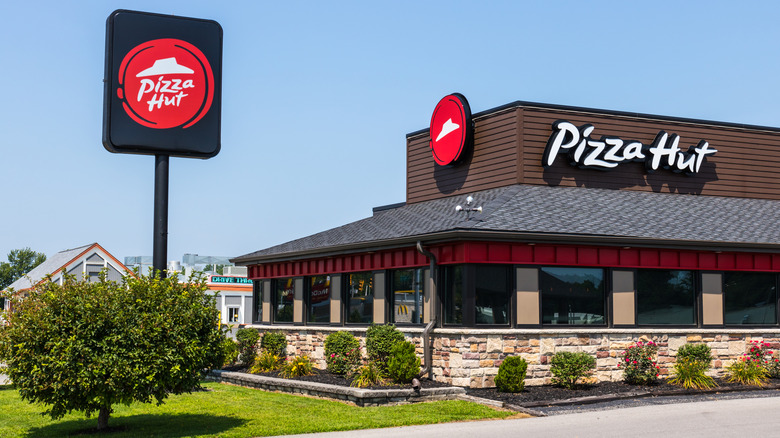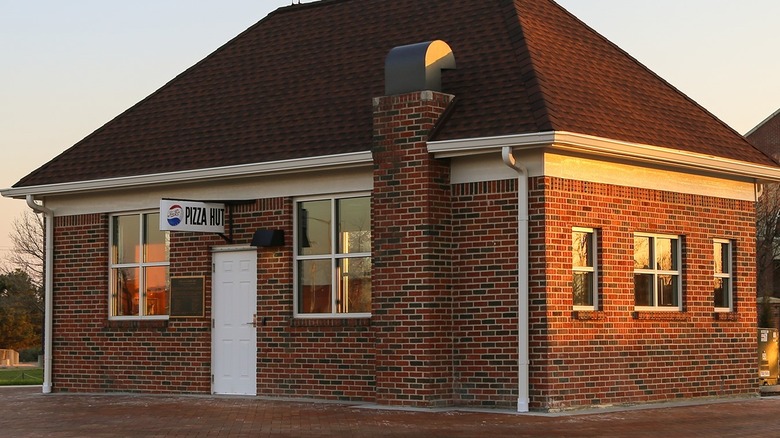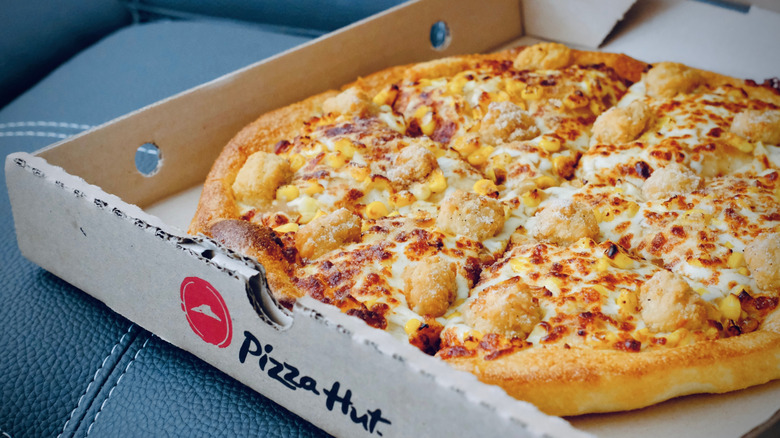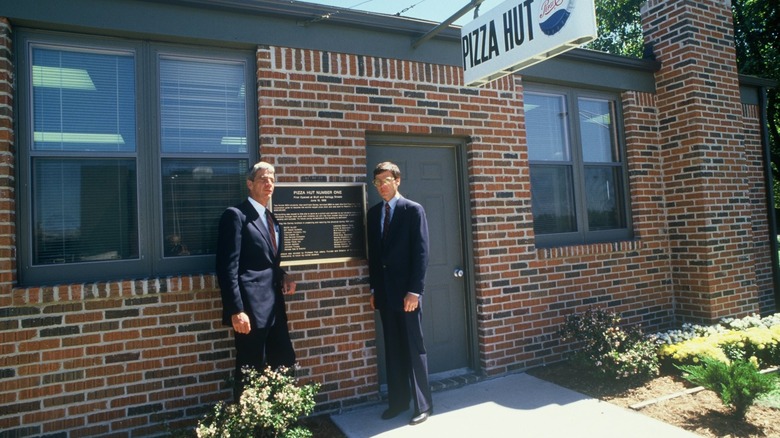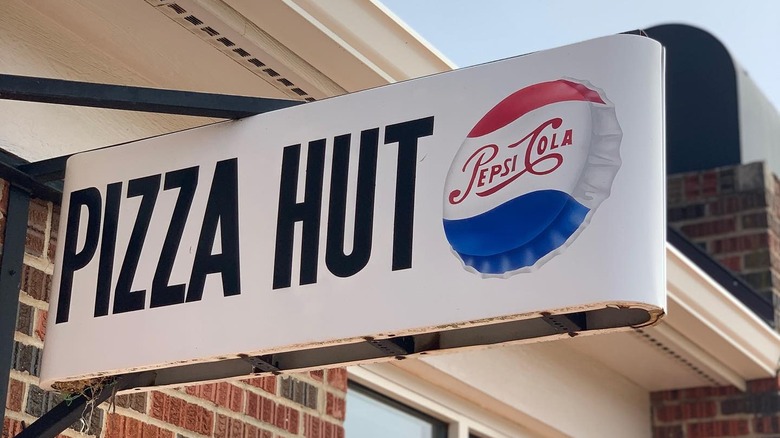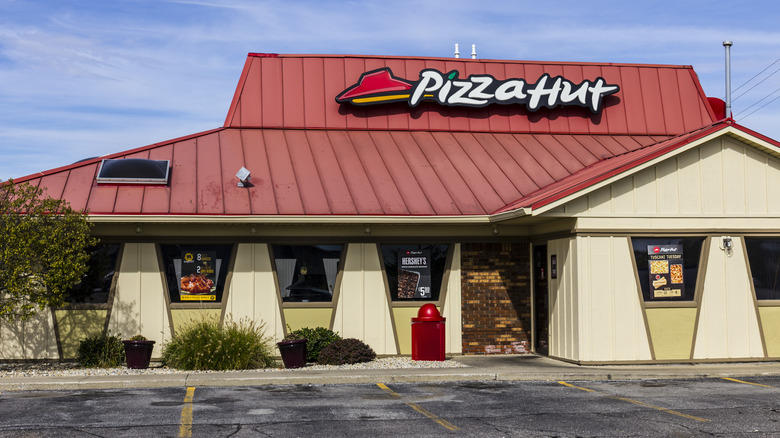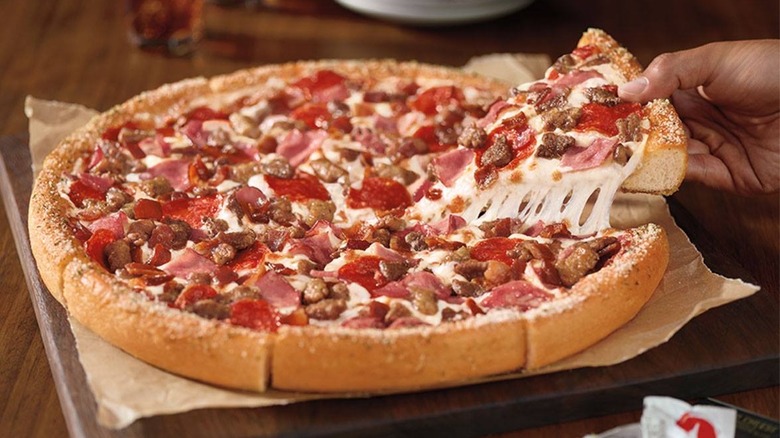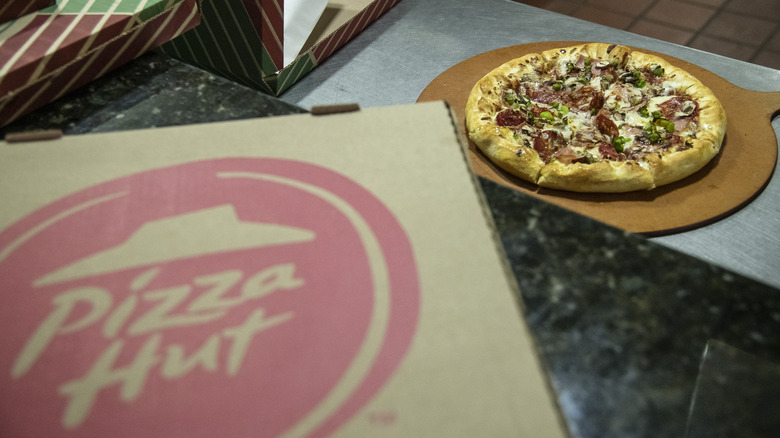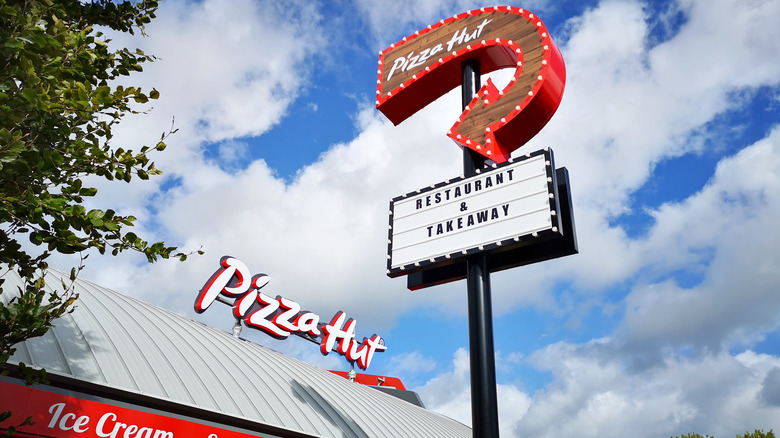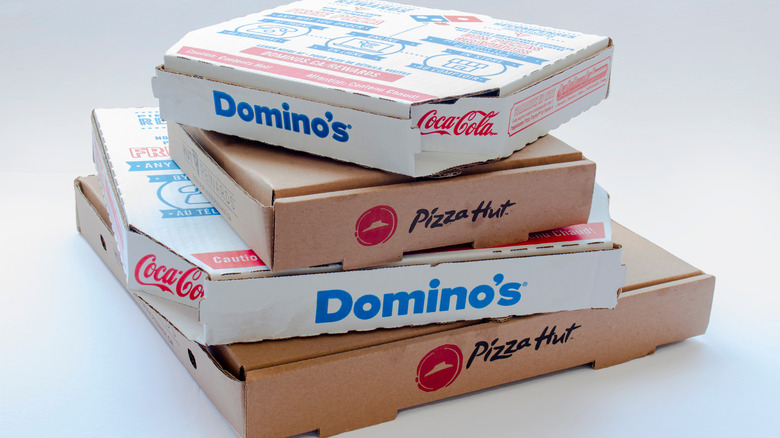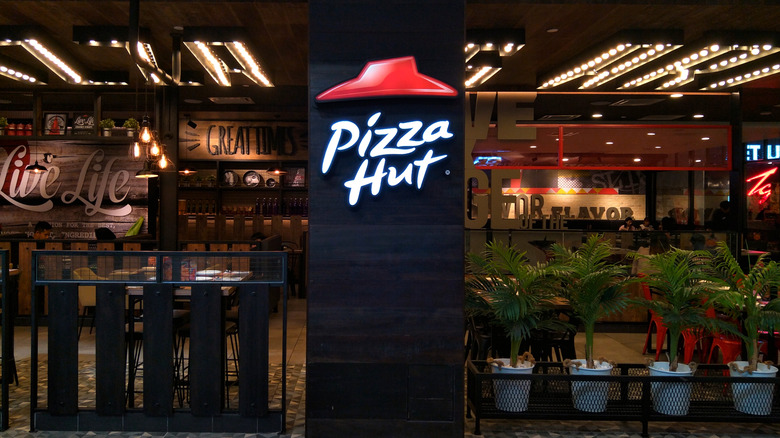The Truth About The Brothers Who Started Pizza Hut
Pizza Hut is an American success story if there ever was one. It started out as a business dream shared by two young brothers in the late 1950s — a time when many Americans barely knew what pizza was (via The Hustle). Within just over a decade it became the number one pizza chain in the world. Today, Pizza Hut still has more locations worldwide than any other pizza chain (more than 16,000), while ranking second in global sales, after Domino's pulled ahead in 2018 (via Pizza Today).
To put it even more plainly — we have Pizza Hut largely to thank for the rise of pizza as a mainstream comfort food in America. Pizza lovers exist far and wide (honestly, are there really people out there who don't like pizza?). There are hardly any cities or towns in this country where you can't find somewhere to get a slice nowadays. And it all goes back to two college kids in Kansas. This is the truth about the brothers who started Pizza Hut.
The brothers who started Pizza Hut have their mom and dad to thank for their success
Like most of us, the brothers who started Pizza Hut wouldn't be anywhere without the help and encouragement of their parents. In the case of Dan and Frank Carney, it was a loan from their mom and some sage wisdom from their dad that led to the rise of a pizza empire.
"Don't work for somebody else if you don't have to." Those were the words of advice the Carney brothers received from their father as they got ready to embark into adulthood, according to the Pizza Hall of Fame. So when Dan was a 26-year-old master's student, and Frank was a 19-year-old freshman, they took that advice, and borrowed $600 from their mother to buy the space and the equipment to open a restaurant (per Pizza Hut). And you could say the rest is history.
Dan and Frank Carney didn't intend to start a pizza empire
When Dan and Frank Carney set out to start a business, they never imagined they would be creating one of the biggest pizza empires in the world. At the time, Frank was simply looking for a way to pay for school, and Dan was seeking an opportunity to launch his career (per the New York Times).
In fact, the Carney brothers didn't even intend to sell pizza at first. According to the Wall Street Journal, Frank had only tried it once in his life. But when they purchased the building to house their restaurant, the woman who sold it to them suggested they try out pizza. According to the Pizza Hall of Fame, she'd recently read an article about pizza's popularity in New York (where it was originally introduced by Italian immigrants, per History.com).
Coincidentally, the Carney brothers also happened to know a guy named John Bender, who knew how to make pizza, and he helped them develop their first Pizza Hut recipe (via The Balance). So the brothers took a gamble and leveraged all their hopes on this thing called pizza. And boy did it pay off.
The Carney brothers weren't quite as inexperienced as they are portrayed
While the story of Pizza Hut sounds more exciting when it involves two kids with nothing more than a pipe dream, that's not exactly an accurate depiction of the Carney brothers as they set out to start a business. Dan and Frank Carney are often described as college dropouts who didn't have a clue what they were doing when they started out (this is true of the History Channel's retelling of the Pizza Hut story in The Food That Built America). But truth be told, they had a little bit of experience under their belt to help set them up for success.
The Carney brothers had early exposure to the food business. Growing up, they worked for their father, who was a local grocer (via The Balance). They also educated themselves about business before starting a restaurant. According to The Sunflower, the Wichita State University newspaper, both Carney brothers took an entrepreneurial course "which was a pivotal step in their journey."
It's also worth noting that while Dan and Frank did both drop out of school as Pizza Hut took off, both brothers eventually went back and completed their Masters and undergraduate degrees, respectively (per the Wichita Eagle and New York Times). In fact, according to The Balance, when Dan returned to WSU to finish his Master's in business, he was told that "due to his success, he'd be better off teaching the course."
The Carney brothers stumbled into the name of their brand
The whole story of Pizza Hut seems to be a series of very fortunate events for the Carney brothers. So it should come as no surprise that the name for this eventual pizza powerhouse came about simply by happenstance. Mashed got the inside story of how Pizza Hut got its name during an exclusive interview with foodie and TV personality, Adam Richman, who learned all about the company as a contributor on History Channel's The Food That Built America.
As Richman tells it, when the Carney brothers bought their restaurant, "they had a freebie sign, a sign that the Coca-Cola company had given them." The catch was that the sign could "only fit eight letters on it. Five letters had to be 'pizza,' which left them three. So they were trying 'pizza pit.' And they went, 'not pizza pit.' And they went, 'Pizza Hut?' And that's what they went with." Other reports say that their original location, which was a small red brick building resembling a hut itself, lent some inspiration to the name as well.
The Carney brothers called on a college friend to help create their iconic store design
When you think of Pizza Hut, chances are the words don't pop into your mind without that telltale red roof perched on top of them. The design was born in 1969, and has served as Pizza Hut's logo for 50 years (per Pizza Hut). The Carney brothers have an old college friend to thank for their iconic branding.
According to the company's blog, in the late 60s, the Carney brothers were beginning to worry about growing competition as they looked to keep expanding. They knew they needed distinctive branding to set them apart and make them recognizable everywhere. So they called up a fraternity brother who happened to be an artist and architect, Richard Burke. Pizza Hut says "the red roof design was a fusion of common sense, the architectural taste of the 1950s, and a need for the design to be both remarkable and appealing in a variety of locations."
They may have been friends, but Burke did not work for the Carney brothers for free. Pizza Hut says Burke charged a "hefty upfront fee that the fledgling pizza start-up wasn't able to scrape together." So instead the Carney brothers offered Burke a commission of $100 for every store built with his design. Little did they know that they were on the peak of exponential growth, eventually opening thousands of "Red Roof" Pizza Hut locations around the world (via Bloomberg).
Frank Carney came up with the signature "original pan pizza" recipe
While it's not the original recipe that put it on the map in the 1960s and 70s, Pizza Hut's signature Original Pan Pizza is undoubtedly what the chain is now known and loved for. And that recipe was developed by none other than Frank Carney himself (per the New York Times).
Pizza Hut's signature pan pizza was put on the menu at all of its locations in 1980, replacing their original recipe which had a thin and crispy crust, reminiscent of Neapolitan or New York-style pizza (via AK Crust). Adam Richman explained to Mashed that part of the inspiration for a new recipe came as Pizza Hut started to realize "their pizza wasn't selling very well on the East Coast. And they decided that they were going to make something else. They made the pan pizza. And the idea was, 'We're not going to try to be you. We're not going to try to do Neapolitan pizza. We're going to try to do this thing, this other thing.'"
Pizza Hut says Frank's original recipe "forever changed the pizza-eating experience for America by introducing a pizza that was crispy on the outside and soft and chewy on the inside." And it remained pretty much unchanged at Pizza Hut for four decades. The company decided to introduce a new Original Pan Pizza recipe in 2019, which was said to have "a crispier crust and more flavorful blend of sauce and cheese."
The Carney brothers were among some of the early pioneers of food franchising in the U.S.
The story of Pizza Hut and the Carney brothers is also a story of the power of franchising. In the 1950s, the fast food industry was exploding, thanks to the development of the U.S. highway system and a thriving middle class that was increasingly buying cars, leading to a growing need for food franchising to reach more customers in the suburbs and beyond (via Smithsonian Magazine).
Dan Carney himself has admitted that when he and his brother, Frank, were starting out "franchising was pretty much relegated to the auto business at that time" (per The Balance). But Dan was convinced that franchising was the future of the food industry, having witnessed the recent growth of McDonald's (which started franchising in 1955), KFC (1952), and Burger King (1954).
Pizza Hut opened its first franchised location just a year after serving up its first pizza. Pizza Hut's franchising strategy is arguably one of the biggest factors behind their rapid growth. The Carney brothers offered low fees — $100 for the license, plus $100 per month in royalties (per the Pizza Hall of Fame) — and were hopeful business owners started flocking. Within just 10 years, more than 300 Pizza Hut restaurants had opened (via CNN).
Being in business together was easy for the Carney brothers
The world of business can be cutthroat, and the idea of working closely alongside a family member through the ups and downs of growing an international brand seems daunting, and wrought with the potential for disaster. Yet Dan and Frank Carney made it look easy for a pair of brothers to come together and build an empire.
According to Pizza Hut historian and Wichita State faculty member, Jay Price, the Carney brothers' differences in personality is what made them such a great team. Speaking to The Sunflower, Price said "Frank was the more outgoing of the two, he tended to be a little more front of house," while "Dan was more on the management side of the business and focused more on the structure." Price also added that the brothers "worked well together because they understood the importance of relationships when building a successful business."
The Carney brothers never tried to buy out Domino's
Pizza Hut returned to the media spotlight recently in the History Channel's The Food That Built America, which looks at the origin stories of some of the most iconic and influential food brands in America. And while the show provides some fascinating insight into the Carney brothers and the rise of Pizza Hut, it seems that the show got some details wrong, much to the dismay of Dan Carney himself.
Specifically, there's a claim made on the show that the Carney brothers approached the founders of Domino's in the 1970s — as the rival pizzeria based out of Michigan was starting to build up a name for itself — with an offer to buy the chain. Dan Carney told the Wichita Eagle that this is blatantly false. Not only did the Carney brothers never approach Domino's with an offer, but Dan says he never even met the founders until decades later, well after Pizza Hut had been sold to PepsiCo. In fact, Dan Carney was pretty upset with the entire episode, saying "it was just horribly done," and "served as a rather prejudiced ad for Domino's."
Both of the Carney brothers got the chance to be head of the company
The idea of two brothers running a business together, let alone a multi-million dollar fast food giant, is bound to spark some sibling rivalry. But it seems the Carney brothers were able to keep that in check, as they both got their chance to be head of Pizza Hut.
The eldest brother, Dan, was the first president and CEO of the company. He led Pizza Hut for more than a decade, and then handed the reins over to his younger brother, Frank. By 1973, Frank Carney was president, chairman, and CEO of Pizza Hut (per Encyclopedia.com), just one year after the company went public. According to reports, that IPO decision is what pushed Dan to step down (via Franchisopedia). As he put it "I didn't want to spend 18 hours a day from now on heading the company up, but Frank was chomping at the bit to do it" (via Pizza Marketplace). Frank Carney remained the president of Pizza Hut through its 1977 acquisition by PepsiCo, stepping down and leaving the company in 1980.
Only one Carney brother stayed in the pizza business after leaving Pizza Hut
The Carney brothers haven't been associated with Pizza Hut for more than three decades now, but one of them eventually returned to the pizza business with a major bang.
After the brothers sold Pizza Hut in 1977, Dan went on to build an accomplished career in business as a venture capitalist, a board member for several companies, and a leader in several charitable organizations in Kansas (via The Balance).
Frank walked away from Pizza Hut in 1980, and had his own stint in venture capitalism. Unfortunately, it resulted in him losing nearly all of his wealth by the early 1990s. So he decided to get back into pizza. But instead of returning to the company he founded, he was enticed by a former Pizza Hut board member to check out a growing rival franchise, Papa John's (per Pizza Marketplace). The move was reportedly sparked in part by PepsiCo's decision to move Pizza Hut's headquarters from Wichita to Dallas, a decision Carney disagreed with. So he went all in, and in 1997 even appeared in national commercials for Papa John's, which sparked a legal battle with Pizza Hut (as explained by Mental Floss). Carney eventually became one of the largest Papa John's franchisees, with more than 130 locations (per Wichita Eagle).
Frank Carney passed away in December 2020 from pneumonia. He is survived by his brother, along with his third wife, and nine children (per the New York Times).
